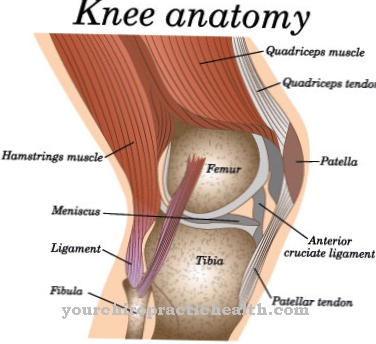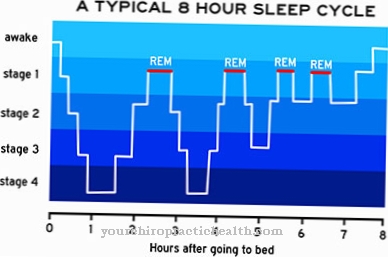The Midbrain syndrome is the result of an increase in intracranial pressure in the area of the middle cranial fossa and is related to compression of the midbrain structure. The most common causes of the syndrome are bleeding and edema. The treatment is usually intensive medical care and, in addition to maintaining vital functions, usually includes a neurosurgical pressure reduction.
What is midbrain syndrome?

© matis75 - stock.adobe.com
The mesencephalon forms part of the brain stem. The neurologist also calls the part of the brain between the pons and the diencephalon the midbrain. In the midbrain, pathways and nerve nuclei are located, which are vital for humans. As Midbrain syndrome pressure damage to the midbrain that can be associated with different symptoms is summarized.
An increase in intracranial pressure primarily forms the framework for acute midbrain symptoms. With increasing intracranial pressure, brain structures can leave their physiological position and become squeezed. As a rule, the midbrain is jammed in the tentorium cerebelli, the so-called cerebellar tent.
It is a transverse meningeal structure between the occipital lobes in the supratentorial space and the cerebellum in the infratentorial space. A jamming of the part of the brain can only occur after increasing pressure in the area of the middle cranial fossa. The causes for an increase in pressure in this area can be of different nature.
causes
An acute midbrain syndrome is preceded by intracranial pressure-increasing processes such as edema formation. Such edema formations can occur in the context of various diseases, such as brain tumors, cerebral infarctions or toxic ischemia. A stroke can also result in cerebral edema.
In principle, however, strokes and tumors can result in midbrain syndrome even without accompanying edema formation. All of the processes mentioned cause intracranial pressure to rise. There is limited space within the skull. Leaking blood during a stroke takes up more or less space.
The same applies to masses in the brain and water retention in the sense of an edema. Since the brain structures within the cranial cavity can hardly evade, they are pushed together and jam. The result can be midbrain syndrome.
In individual cases, CSF flow disorders are also the primary cause of an obstruction. The cerebrospinal fluid that washes around the central nervous system is called liquor. In individual cases, midbrain syndrome can also be caused by traumatic brain injuries, poisoning or cardiac arrest.
Symptoms, ailments & signs
From a clinical point of view, midbrain syndrome can be divided into three different stages, each characterized by different symptoms. Basically there is a progressive loss of consciousness. In addition, the pupillary reflexes fail during the course. The initial stage is characterized by tachycardia and pathological Cheyne-Stokes breathing.
Those affected sweat and no longer have any pain irritation reactions. Pathological reflexes occur. For example, the Babinski signs are positive. In the third stage of acute midbrain syndrome, patients suffer from light-rigid pupils. In addition, stretch synergisms occur in the form of a so-called rigidity of decerebration. This symptom is explained by the failure of all inhibitory pathways.
The reflexes are overactive in this phase. We are also talking about hyperreflexia. Since the midbrain syndrome ends in a coma during the third stage, the vital functions of the patients are threatened in the late course of the syndrome. As the damage progresses due to increasing intracranial pressure, the midbrain syndrome usually changes smoothly into a life-threatening bulbar brain syndrome.
Diagnosis & course of disease
The neurologist receives the first indications of a midbrain syndrome from the anamnesis. The standard reflex test confirms the first suspected diagnosis. To confirm the diagnosis of midbrain syndrome, the neurologist uses imaging diagnostics. In most cases, he will order an MRI. The jamming of the midbrain can be clearly seen on the slice image.
A measurement of the intracranial pressure is absolutely necessary when indicated. The measurement is continuously repeated in the course of the process in order to detect a continuous rise in pressure as early as possible and to be able to intervene. The prognosis for patients with midbrain syndrome depends on the time of diagnosis. The diagnosis in the first stage has a positive prognostic effect.
Complications
Midbrain syndrome causes various limitations and complaints in patients. These can lead to paralysis or other disorders of sensitivity and thus have a very negative effect on everyday life and the patient's quality of life. Those affected are often dependent on the help of other people in their everyday life and can usually no longer carry out simple activities.
It is not uncommon for this to result in rigidity and unusual breathing. Those affected can also fall into a coma and no longer actively participate in life. For relatives, children or partners in particular, midbrain syndrome can lead to very serious psychological complaints and stress, so that they too are dependent on psychological treatment.
As a rule, midbrain syndrome can be treated with the help of medication, which usually targets the underlying disease. However, it cannot be generally predicted whether this will lead to a positive course of the disease. As a rule, midbrain syndrome does not reduce or limit the life expectancy of patients.
When should you go to the doctor?
A disturbance of consciousness is the first sign of a brain disease. A doctor visit is required as soon as there are irregularities in consciousness, headaches or attention deficits. A drop in performance, concentration problems or functional disorders should be examined by a doctor. If a loss of consciousness occurs, an ambulance service must be alerted immediately.
Emergency care as well as intensive medical care for the person affected are necessary. Medical tests will be done so the cause of the symptoms can be clarified and treated. Those present are obliged to take first aid measures until the emergency doctor arrives. This is the only way to ensure the survival of the person affected.
A doctor is required in the event of irregular breathing, disorders of the reflexes or profuse sweating. In particular, the loss of the pupillary reflexes must be discussed with a doctor. A doctor must be consulted if there is a loss of pain sensation or if the existing symptoms increase in intensity. A pale complexion, apathy and indifference are signs of an existing illness.
Since midbrain syndrome can lead to a life-threatening condition, a doctor should be consulted if there is an increasing tendency towards malaise or malaise. Memory disorders, disorientation and impaired cognitive performance must be examined by a doctor.
Treatment & Therapy
Therapy for midbrain syndrome depends on the stage and cause of the appearance. The main focus of the treatment is on safeguarding the vital functions. In addition, the brain metabolism must be kept going and the intracranial pressure monitored. To maintain vital functions, patients are given ventilation with controlled hyperventilation.
The conservative drug therapy corresponds to the administration of catecholamines. In addition, a volume substitution usually has to take place. If the vital functions are stabilized, the lowering of the intracranial pressure is the final therapy goal. The most effective method of lowering intracranial pressure depends on the primary cause of the increase in pressure. In addition to neurosurgical lowering, mannitol or ventricular drainage can be important starting points.
While the pressure is being reduced, not only the pressure conditions, but also the patient's vital functions must be continuously monitored. This monitoring takes place via intensive medical monitoring. The acute decrease in intracranial pressure is followed by the elimination of the primary cause. This elimination of the causes is carried out by means of neurosurgical intervention.
If the primary cause was, for example, leaked blood, hematoma removal is used as a causal therapy. In the case of causal masses, however, tumor extirpation takes place. Whether patients recover completely from midbrain syndrome depends on the severity of the bruises and the affected areas; rehabilitation measures can promote the regression of any long-term effects.
You can find your medication here
➔ Medicines for headaches and migrainesOutlook & forecast
Midbrain syndrome offers a relatively poor prognosis and means a significant reduction in quality of life for those affected. When the syndrome occurs, there is usually already considerable brain damage, which leads to serious complications or death of the patient. Severe symptoms such as increased intracranial pressure or coma often take a severe course. The patients have to be artificially ventilated and are usually not responsive.
If the outcome is positive, there is a prospect of recovery, provided that no serious physical damage has occurred. In general, the prognosis depends on the timing of treatment and the severity of the causative traumatic brain injury. If the trauma is treated immediately, the prognosis is better. In the absence of treatment, midbrain syndrome is always fatal.
The prognosis is made by the responsible neurologist in consultation with surgeons and other specialists. In order to make a prognosis, the severity of the trauma is included as well as the previous course and any physical and mental damage. The prognosis is relatively reliable, since organ damage that has already occurred can usually no longer be treated and a traumatic brain injury, once overcome, does not necessarily lead to complications.
prevention
Midbrain syndrome can only be prevented to the extent that an increase in pressure in the area of the middle cranial fossa can be prevented. The preventive measures in the context of cerebral infarction can, in the broadest sense, be counted among the preventive measures, for example.
Aftercare
In the case of midbrain syndrome, in most cases the patient has very few and usually only very limited options for follow-up care, so that the person affected is primarily dependent on early diagnosis and rapid treatment of this disease in order to avoid further complications and complaints to prevent. Self-healing cannot occur, so treatment by a doctor is always necessary.
Most people with midbrain syndrome have to have surgery. The affected person should definitely take it easy after such an operation, whereby bed rest must also be observed. It is also not uncommon to take various medications to alleviate the symptoms.
The doctor's instructions must be followed, with regular intake and the correct dosage. Most patients also need psychological support during treatment and are also dependent on the help of their own family in everyday life. No general prediction can be made about the further course of the midbrain syndrome, as this depends heavily on the time of diagnosis.
You can do that yourself
In the case of midbrain syndrome, in most cases the person affected has no options for self-help. In any case, medical assistance is required to reduce and limit the symptoms and symptoms of this syndrome.
In many cases, the relatives or parents of the person concerned also suffer from severe psychological complaints or from depression. Psychological treatment is useful in order not to burden the patient with it. The loving help and care of relatives can also have a positive effect on the course of midbrain syndrome. If the person concerned falls into a coma, no direct help can usually be given. Daily care and the prevention of psychological complaints makes sense here. With midbrain syndrome, those affected depend on regular controls and examinations, which should be carried out especially at an older age or if symptoms persist.
Since breathing is also negatively affected by the syndrome, the person affected should take it easy and not engage in strenuous or sporting activities. Unfortunately, it cannot generally be predicted whether midbrain syndrome will lead to a reduced life expectancy.

.jpg)
.jpg)

.jpg)

.jpg)

















.jpg)



